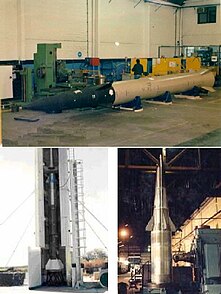Condor (Argentine missile)
This article needs additional citations for verification. (February 2013) |

The Argentine Condor missile was a multinational space research program started in the 1970s. It involved significant contract work being performed by German company MBB (now a group within Daimler AG), but later developed into a ballistic missiles program.
Condor I[edit]
The original Condor[1] had little military capability but helped build expertise later used for the Alacrán missile program.[2][3] The Alacrán program developed a functional short-range ballistic missile.
Specifications (Condor I)[edit]
- Length: 8 metres (26 ft)
- Maximum diameter: 70 centimetres (28 in)
- Stages: 1
- Fuel: HTPB
- Guidance system: inertial
- Apogee: 300 kilometres (190 mi)
- Range: 100 kilometres (62 mi)
- Payload: 500 kilograms (1,100 lb)
Alacrán (Condor IAIII)[edit]

The Alacrán missile was a short range ballistic missile derived from the Condor Missile Program.[4]
Derived from the Condor IAIII prototype, the Alacrán missile had shorter stabilization fins, an inertial guidance system, and a 1000CAP1 cluster warhead.
Specifications (Condor IAIII - Alacrán)[edit]
- Length: 8 metres (26 ft)
- Maximum diameter: 70 centimetres (28 in)
- Stages: 1
- Fuel: HTPB
- Guidance system: inertial
- Apogee: 100 kilometres (62 mi)
- Range: 115 kilometres (71 mi)
- Warhead: 1000CAM1 cluster munition warhead, 500 kilograms (1,100 lb)
Condor II[edit]

During and after the 1982 Falklands War (Spanish: Guerra de las Malvinas), France (which supplied missiles) placed an arms embargo on Argentina, causing the Argentine Air Force, under the command of Ernesto Crespo, to develop its own medium-range missile in the Condor II[5] program.
This program was undertaken in close collaboration with Egypt,[6] and then Ba'athist Iraq[7] (the Iraqi version was called BADR-2000),[8] however it was discontinued in the early 1990s by President Carlos Menem because of political pressure from the United States.[9][10] The missile was developed in Falda del Carmen, Córdoba Province.
The Condor missile had a range of 800 km to 1,000 km[11][12] and a 1000CAP1 500 kg cluster munition warhead.
In 1997, the Argentine Air Force reported to the US Congress that it still possessed two of the missiles that were to be destroyed.[13][14][citation needed]
Condor III[edit]
There have been reports of a Condor III program. The Condor III would have an increased range to some 1,500 km (930 mi) with the same payload as the Condor II.[11][15]
See also[edit]
References[edit]
- ^ "Condor 1". Astronautix.com. Archived from the original on October 22, 2003. Retrieved 2013-10-14.
- ^ "Alacran". Astronautix.com. Archived from the original on September 2, 2003. Retrieved 2013-10-14.
- ^ Joseph Cirincione; Jon B. Wolfsthal; Miriam Rajkumar (December 2011). Deadly Arsenals: Nuclear, Biological, and Chemical Threats. Carnegie Endowment. pp. 388–. ISBN 978-0-87003-288-2.
- ^ Joseph Cirincione; Jon B. Wolfsthal; Miriam Rajkumar (December 2011). Deadly Arsenals: Nuclear, Biological, and Chemical Threats. Carnegie Endowment. pp. 388–. ISBN 978-0-87003-288-2.
- ^ "Condor 2". Astronautix.com. Archived from the original on October 22, 2003. Retrieved 2013-10-14.
- ^ "Egypt's Missile Efforts Succeed with Help from North Korea". Wisconsin Project on Nuclear Arms Control. 1996. Archived from the original on 2016-01-23.
- ^ "Argentina | Country Profiles". NTI. Archived from the original on 2013-12-26. Retrieved 2013-10-14.
- ^ "Badr-2000 - Iraq Special Weapons". Fas.org. Retrieved 2013-10-14.
- ^ "Condor Missile Programme (Hansard, 5 March 1996)". Parliamentary Debates (Hansard). 1996-03-05. Retrieved 2013-10-14.
- ^ Cirincione, Joseph; Jon B. Wolfsthal; Miriam Rajkumar (2005). Deadly arsenals : nuclear, biological, and chemical threats (Second ed.). Washington, D.C. ISBN 978-0-87003-288-2. OCLC 823345765.
{{cite book}}: CS1 maint: location missing publisher (link) - ^ a b "Egypt Missile Chronology" (PDF). Nti.org. Retrieved 2016-01-26.
- ^ Etel Solingen (9 February 2009). Nuclear Logics: Contrasting Paths in East Asia and the Middle East. Princeton University Press. pp. 230–. ISBN 978-1-4008-2802-9.
- ^ Cirincione, Joseph; Jon B. Wolfsthal; Miriam Rajkumar (2005). Deadly arsenals : nuclear, biological, and chemical threats (Second ed.). Washington, D.C. ISBN 978-0-87003-288-2. OCLC 823345765.
{{cite book}}: CS1 maint: location missing publisher (link) - ^ Robert E. Dundervill, Jr.; Peter F. Gerity; Anthony K. Hyder; Lawrence H. Luessen (9 March 2013). Defense Conversion Strategies. Springer Science & Business Media. pp. 200–. ISBN 978-94-017-1213-2.
- ^ "Misil Condor III y Cohete tronador II (y algunos mas)". Taringa.net. 3 September 2011. Retrieved 2016-01-26.
External links[edit]
- (in Spanish) Condor 1-AIII
